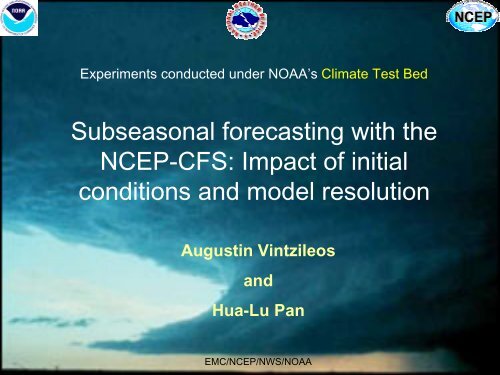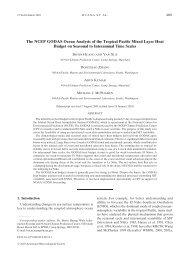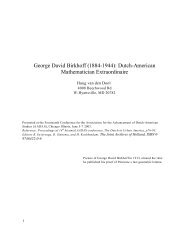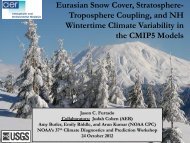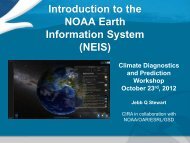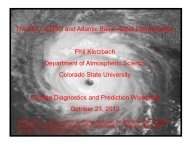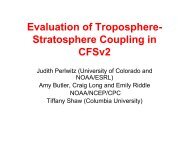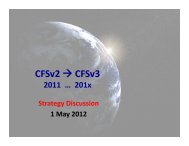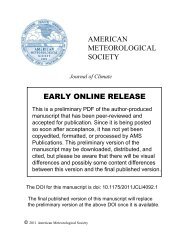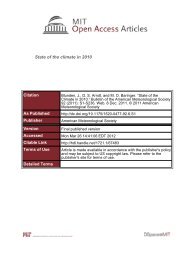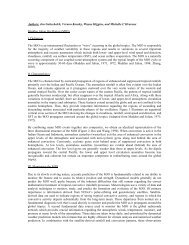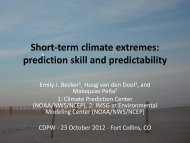Impact of initial conditions and model resolution - NOAA
Impact of initial conditions and model resolution - NOAA
Impact of initial conditions and model resolution - NOAA
You also want an ePaper? Increase the reach of your titles
YUMPU automatically turns print PDFs into web optimized ePapers that Google loves.
Experiments conducted under <strong>NOAA</strong>’s Climate Test Bed<br />
Subseasonal forecasting with the<br />
NCEP-CFS: <strong>Impact</strong> <strong>of</strong> <strong>initial</strong><br />
<strong>conditions</strong> <strong>and</strong> <strong>model</strong> <strong>resolution</strong><br />
Augustin Vintzileos<br />
<strong>and</strong><br />
Hua-Lu Pan<br />
EMC/NCEP/NWS/<strong>NOAA</strong>
The Operational Climate Forecast System<br />
Atmosphere<br />
• Global Forecast System 2003 (GFS03)<br />
• T62 in horizontal; 64 layers in vertical<br />
• Recent upgrades in <strong>model</strong> physics<br />
‣ Solar radiation (Hou, 1996)<br />
‣ cumulus convection (Hong <strong>and</strong> Pan, 1998)<br />
‣ gravity wave drag (Kim <strong>and</strong> Arakawa, 1995)<br />
‣ cloud water/ice (Zhao <strong>and</strong> Carr,1997)<br />
Coupling<br />
once per day, no flux correction.<br />
Ocean<br />
• GFDL MOM3 (Pacanowski <strong>and</strong> Griffies, 1998)<br />
• 1/3 ·1 in tropics; 1 ·1 in extratropics; 40 layers<br />
• Quasi-global domain (74 S to 64 N)<br />
• Free surface
Dynamical Forecasting: from Weather to Climate<br />
Atmospheric<br />
<strong>initial</strong> <strong>conditions</strong><br />
Forecast lead times<br />
L<strong>and</strong> <strong>initial</strong><br />
<strong>conditions</strong><br />
0-14 days 15-90 days 90 days <strong>and</strong> beyond<br />
Synoptic<br />
Subseasonal<br />
Seasonal-to-Interannual<br />
Oceanic <strong>initial</strong><br />
<strong>conditions</strong><br />
Mainly affected<br />
by Atmospheric<br />
I.C.<br />
Affected by all I.C.<br />
Mainly affected by Oceanic I.C.<br />
but also by l<strong>and</strong> I.C. (e.g., snow<br />
cover)<br />
Weather<br />
MJO affecting<br />
weather statistics<br />
ENSO affecting<br />
weather statistics
Issues : Which Model Resolution
Currently:<br />
Weather forecast (GFS) <strong>initial</strong>ized by GDAS<br />
T382L64 to 7 days<br />
T190L64 to 16 days<br />
GDAS<br />
Seasonal forecast (CFS) <strong>initial</strong>ized by CDAS-2/GODAS<br />
T62L64 to 9 months<br />
CDAS<br />
(Next implementation T126L64)
Dynamical Forecasting: from Weather to Climate<br />
Atmospheric<br />
<strong>initial</strong> <strong>conditions</strong><br />
Forecast lead times<br />
L<strong>and</strong> <strong>initial</strong><br />
<strong>conditions</strong><br />
0-14 days 15-90 days 90 days <strong>and</strong> beyond<br />
Synoptic<br />
Subseasonal<br />
Seasonal-to-Interannual<br />
Oceanic <strong>initial</strong><br />
<strong>conditions</strong><br />
Mainly affected<br />
by Atmospheric<br />
I.C.<br />
Affected by all I.C.<br />
Mainly affected by Oceanic I.C.<br />
but also by l<strong>and</strong> I.C. (e.g., snow<br />
cover)<br />
Weather<br />
MJO affecting<br />
weather statistics<br />
ENSO affecting<br />
weather statistics
Issues : Initialization<br />
• Is it better to use a frozen reanalysis system (which is<br />
preferable when bias correction is crucial) rather than the<br />
best <strong>initial</strong> <strong>conditions</strong> available at the time <strong>and</strong> an estimate<br />
for bias correction<br />
• What is the impact <strong>of</strong> <strong>initial</strong>izing the subseasonal forecast by<br />
GDAS (operational analysis) or Reanalysis-2
GDAS vs. GPCP vs. Reanalysis-2 for June 2002<br />
GDAS Precipitable<br />
Water<br />
GPCP Precipitation<br />
Reanalysis 2<br />
Precipitable Water<br />
drift<br />
Time evolution <strong>of</strong> mean energy at<br />
wave numbers 10-40 when CFS is<br />
<strong>initial</strong>ized by R2 (red) or by GDAS<br />
(blue).
Retrospective forecast design:<br />
May 23 rd to August 11 th from 2002 to 2006<br />
1 forecast every 5 days, with additional re-forecasts at the beginning <strong>of</strong><br />
each month<br />
Forecast lead: 60 days<br />
Model <strong>resolution</strong>:<br />
Atmosphere: T62 = 200Km x 200Km<br />
T126 = 100Km x 100Km<br />
T254 = 50Km x 50Km<br />
Ocean: the st<strong>and</strong>ard CFS <strong>resolution</strong><br />
Initial <strong>conditions</strong>:<br />
Atmosphere, L<strong>and</strong>: from Reanalysis 2 <strong>and</strong> from GDAS<br />
Ocean: from GODAS
Is there an impact <strong>of</strong> <strong>resolution</strong> to large<br />
scales<br />
Consider:<br />
• Root mean square error <strong>of</strong> zonal wind at 200 hPa (U200)<br />
averaged between 20ºS <strong>and</strong> 20ºN.<br />
• Computation using 105 hindcasts for 144 longitudinal<br />
points<br />
• Anomalies are defined in reference to a mean state<br />
computed using the five years (2002-2006)<br />
• Validating against Reanalysis-2
U200 averaged between 20S-20N: no climatologies subtracted<br />
Black = T254<br />
Red = T126<br />
Blue = T62<br />
CDAS<br />
GDAS<br />
CDAS<br />
GDAS<br />
From week<br />
3 <strong>and</strong><br />
beyond we<br />
can clearly<br />
distinguish<br />
between<br />
different<br />
<strong>resolution</strong>s<br />
Because we<br />
validate<br />
against<br />
CDAS<br />
(starting<br />
from 06Z)<br />
Up to week-3 GDAS is better than CDAS.<br />
Resolution is marginally important
U200 averaged between 20S-20N: climatologies subtracted<br />
v2 x<br />
Climatological<br />
Forecast<br />
CDAS <strong>initial</strong>ized<br />
T62 hindcasts are<br />
the worst<br />
Because we<br />
validate<br />
against<br />
CDAS<br />
(starting<br />
from 06Z)<br />
GDAS <strong>initial</strong>ized<br />
T254 hindcasts<br />
are the best<br />
Lead times from 0 to 25 days
U200 averaged between 20S-20N climatologies subtracted<br />
We still can<br />
distinguish the<br />
hindcasts as a<br />
function <strong>of</strong><br />
<strong>resolution</strong>.<br />
v2 x Climatological Forecast (i.e., anomaly=0)<br />
Lead times from 25 to 57 days
A first conclusion:<br />
• There is impact <strong>of</strong> both <strong>resolution</strong> <strong>and</strong> <strong>initial</strong> <strong>conditions</strong> to<br />
large scales features at lead times beyond week 2.<br />
• Of course, this impact could be more important for more<br />
local scales.
<strong>Impact</strong> to more local features<br />
• We now explore the impact <strong>of</strong> <strong>resolution</strong> to mean August<br />
(2002-2006) features forecasted from <strong>initial</strong> <strong>conditions</strong><br />
(CDAS <strong>and</strong> GDAS) on July 2 nd , 3 rd , 5 th , 6 th , 7 th , 10 th <strong>and</strong><br />
12 th i.e., a total <strong>of</strong> 70 hindcasts<br />
• Velocity potential at 200 hPa at a global scale <strong>and</strong><br />
precipitation over Tropical Africa <strong>and</strong> Atlantic.
As <strong>resolution</strong> increases there is a shift <strong>of</strong> upper level divergence from the<br />
Philippines Sea to the Arabian Sea <strong>and</strong> over the Sahel which goes along with a<br />
northward shift <strong>of</strong> precipitation there.
In fact, the northward shift <strong>of</strong> the mean<br />
precipitation with <strong>resolution</strong> improves its<br />
simulation
There are also good indications that the forecast skill increases with<br />
<strong>resolution</strong>. As an example we show here August 2003 (a wet year) as<br />
forecasted by <strong>initial</strong> <strong>conditions</strong> in the first half <strong>of</strong> July (14-member ensemble)
For more details on subseasonal forecasting<br />
over the Sahel please visit our poster at the<br />
AMMA session on Thursday…
Other areas:<br />
North American Continent<br />
Tropical Atlantic
Mean August Precipitation<br />
The mean August precipitation is computed by<br />
averaging hindcasts with <strong>initial</strong> <strong>conditions</strong> from<br />
July 2nd, 3rd, 5th, 6th, 7th, 10th <strong>and</strong> 12th using<br />
both CDAS <strong>and</strong> GDAS over the 5 years <strong>of</strong><br />
hindcasts (i.e., based on a 70-member<br />
ensemble forecast)
OBS<br />
T254<br />
T126<br />
The <strong>model</strong> is too<br />
wet at all<br />
<strong>resolution</strong>s in<br />
the western<br />
tropical Atlantic.<br />
Is this due to an<br />
unrealistically<br />
strong<br />
dependence on<br />
SST (i.e.,<br />
physics), weak<br />
intrusions <strong>of</strong> dry<br />
Saharan air –<br />
Under<br />
investigation<br />
T62
OBS<br />
T254<br />
T126<br />
Monsoon<br />
<strong>and</strong> SE<br />
areas well<br />
simulated<br />
T62
Midwest is<br />
too dry at all<br />
<strong>resolution</strong>s –<br />
T62 seems<br />
to be the<br />
best
Forecast <strong>of</strong> August monthly Precipitation<br />
Initial <strong>conditions</strong> from July 2 nd , 3 rd , 5 th , 6 th , 7 th , 10 th <strong>and</strong> 12 th<br />
using both CDAS <strong>and</strong> GDAS<br />
A 14-member ensemble forecast
Tropical Atlantic
OBS<br />
August 2002: weak tropical activity
OBS<br />
August 2005: very strong tropical activity
Some conclusions<br />
• The <strong>model</strong> captures very well the contrast between dry<br />
<strong>conditions</strong> in 2002 <strong>and</strong> wet <strong>conditions</strong> in 2005 at all<br />
<strong>resolution</strong>s.<br />
• In the real system this contrast was due to lower/higher<br />
occurrence <strong>of</strong> tropical systems.<br />
• We currently investigate if the <strong>model</strong> response is due to<br />
less or more tropical systems or a response to just SST
North American continent
Monthly<br />
anomalies<br />
over the<br />
oceans are<br />
simulated with<br />
the correct<br />
amplitude.<br />
However over<br />
the l<strong>and</strong> (with<br />
the noticable<br />
exception <strong>of</strong><br />
Mexico) there<br />
is only a very<br />
weak signal at<br />
all <strong>resolution</strong>s.
Conclusions<br />
-- We performed a series <strong>of</strong> hindcasts <strong>initial</strong>ized during summer months in<br />
order to asses the impact <strong>of</strong> atmospheric <strong>model</strong> <strong>resolution</strong> <strong>and</strong> <strong>initial</strong><br />
<strong>conditions</strong> to subseasonal forecasts.<br />
-- We presented some indication that even for very large scale fields the<br />
impact <strong>of</strong> <strong>initial</strong> <strong>conditions</strong> can be felt as long as week 3 <strong>and</strong> that <strong>resolution</strong><br />
plays a role with T254 experiments <strong>initial</strong>ized by GDAS being the best <strong>and</strong><br />
T62 hindcasts <strong>initial</strong>ized by CDAS being the worst.<br />
-- In this preliminary assessment we have noted that there are areas (e.g.,<br />
United States) where increasing <strong>resolution</strong> improves neither the mean state<br />
nor variability <strong>of</strong> precipitation. For these areas improvements <strong>of</strong> the<br />
parameterization <strong>of</strong> physical processes (or GLDAS) may be the key.<br />
-- There are also areas like the Sahel where <strong>resolution</strong> appears to be critical<br />
for forecasting the mean climate <strong>and</strong> departures from it.<br />
-- Of course there are technical constraints that do not allow (at present) the<br />
operational implementation <strong>of</strong> <strong>resolution</strong>s higher than T126 for<br />
subseasonal-to-seasonal forecasts. Dynamical downscaling may therefore<br />
be an intermediate solution.


